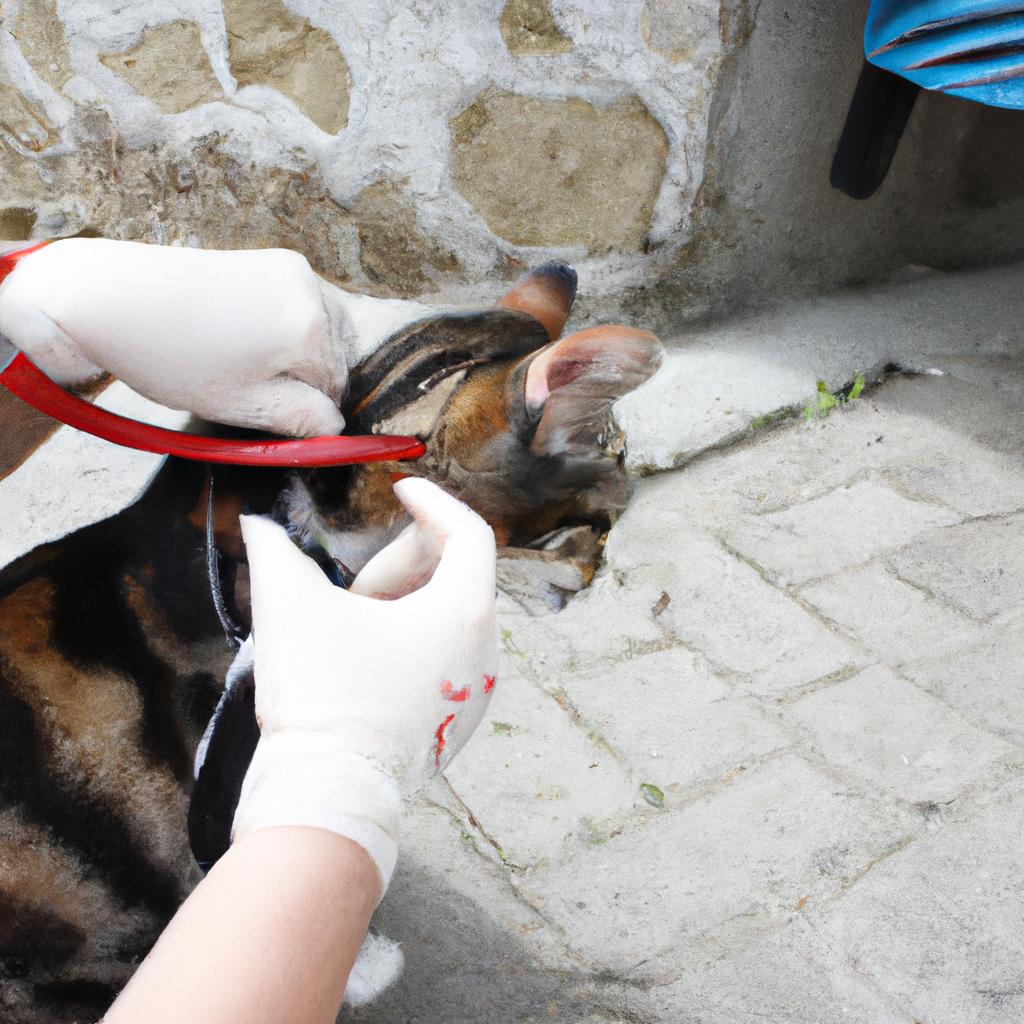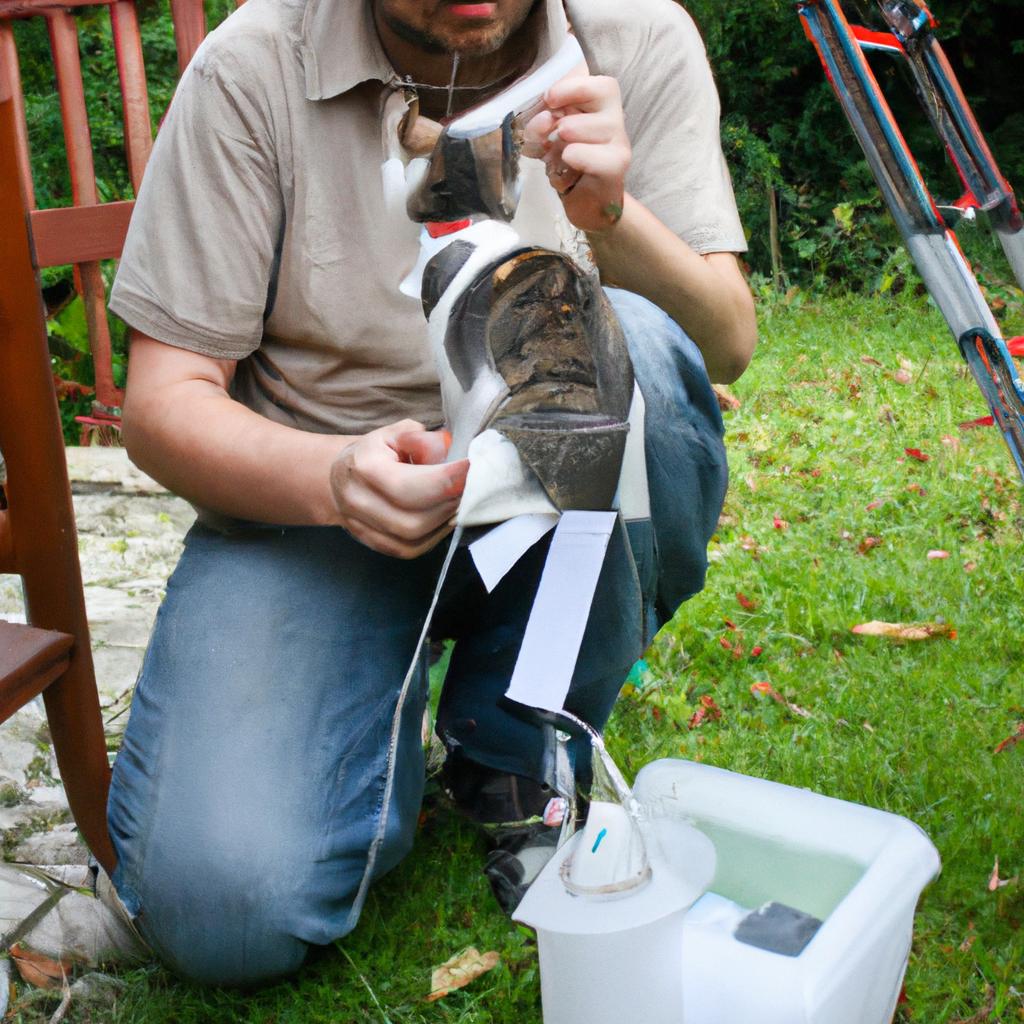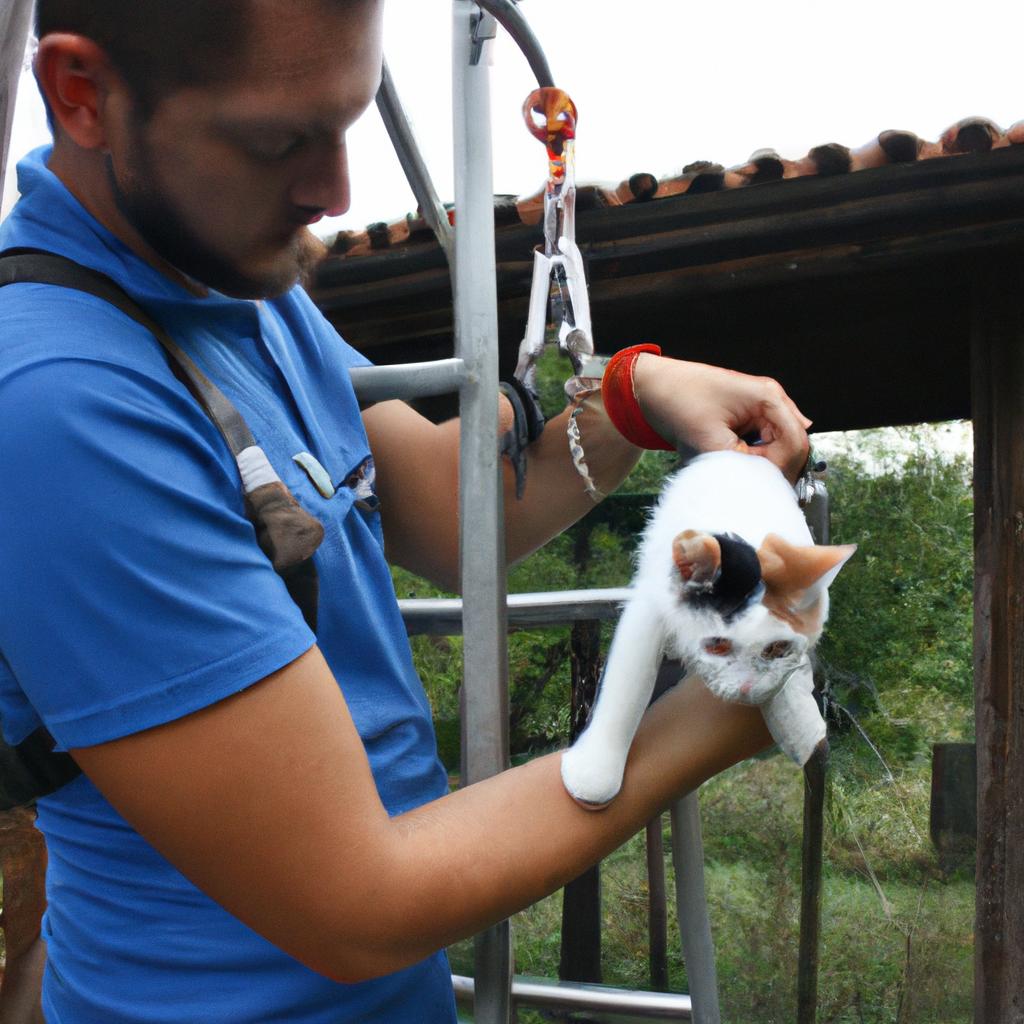The importance of spaying/neutering cats cannot be overstated in the realm of cat rescue initiatives. With an overwhelming population of stray and feral cats, it becomes imperative to address this issue through effective spay/neuter programs. Low-cost spay/neuter clinics have emerged as a potential solution to tackle this problem by offering affordable options for pet owners and rescuers alike. For instance, consider a hypothetical scenario where a local animal shelter partners with a low-cost spay/neuter clinic to provide discounted services to community members. This collaboration not only benefits individual pet owners but also contributes significantly towards reducing the number of unwanted litters and alleviating strain on already overwhelmed rescue organizations.
In recent years, low-cost spay/neuter clinics have gained traction due to their affordability and accessibility. The primary goal of these clinics is to ensure that every cat has access to spaying or neutering services, regardless of the owner’s financial constraints. By providing reduced-rate procedures, these clinics effectively eliminate one of the main barriers preventing many individuals from getting their pets sterilized. Moreover, they play a vital role in addressing the overpopulation crisis by actively promoting responsible pet ownership practices.
Through partnerships between animal shelters and low-cost spay/neuter clinics, communities can implement comprehensive spay/neuter programs that target both owned and unowned cats. These programs typically include initiatives such as trap-neuter-return (TNR) for feral cats, where they are trapped, sterilized, vaccinated, and then returned to their original location. By implementing TNR programs in conjunction with low-cost spay/neuter clinics, communities can effectively manage feral cat populations and prevent them from reproducing uncontrollably.
In addition to reducing the number of unwanted litters and controlling feral cat populations, partnerships between animal shelters and low-cost spay/neuter clinics also have other significant benefits. They help alleviate the burden on rescue organizations by decreasing the influx of homeless cats into shelters. This allows shelters to focus their resources on providing proper care and finding forever homes for the existing population of cats in need.
Furthermore, these collaborations contribute to public health efforts by reducing the spread of diseases commonly associated with unsterilized cats, such as feline leukemia virus (FeLV) or feline immunodeficiency virus (FIV). Spaying/neutering not only eliminates the risk of reproductive-related health issues but also reduces aggressive behavior in male cats and eliminates heat cycles in females, leading to a decrease in territorial marking and unwanted behaviors.
Overall, partnerships between animal shelters and low-cost spay/neuter clinics are crucial for addressing the overpopulation crisis in stray and feral cats. By making sterilization services more accessible and affordable to pet owners and rescuers alike, these collaborations significantly contribute towards responsible pet ownership practices while simultaneously reducing the strain on rescue organizations and improving community well-being.
The Importance of Low-Cost Spay/Neuter Clinics
Imagine a community where stray and feral cats roam freely, reproducing at an alarming rate. Over time, this population grows exponentially, leading to overcrowded shelters and countless homeless cats struggling to survive on the streets. Now, picture a solution that can help address this issue effectively: low-cost spay/neuter clinics. These clinics play a vital role in controlling cat overpopulation by providing affordable sterilization services to pet owners and caretakers who may not have the means to pay for expensive veterinary procedures.
One example highlighting the impact of low-cost spay/neuter clinics is the case study of a small town facing an overwhelming stray cat problem. With limited resources available, the local animal control agency struggled to keep up with the growing number of abandoned cats being brought into their facility each day. Recognizing the urgent need for action, they partnered with a nearby low-cost spay/neuter clinic to implement a targeted trap-neuter-return (TNR) program. By offering discounted or free sterilization surgeries through this collaboration, they were able to reduce the stray cat population significantly within just a few years.
To fully grasp why low-cost spay/neuter clinics are crucial in addressing cat overpopulation, it is important to consider some key points:
- Accessible and Affordable Services: Unlike traditional veterinary clinics that often charge higher fees for sterilization procedures, low-cost spay/neuter clinics aim to make these services accessible and affordable for all individuals concerned about preventing unwanted litters.
- Preventing Future Litters: Sterilizing cats through spaying or neutering helps prevent future litters from being born, ultimately reducing the number of homeless kittens born each year.
- Health Benefits: Apart from curbing reproduction rates, spaying or neutering cats also provides various health benefits such as reducing the risk of certain cancers and eliminating behaviors associated with mating instincts.
- Community Impact: By addressing cat overpopulation, low-cost spay/neuter clinics positively impact the community as a whole. They help alleviate the burden on animal shelters and reduce instances of feral cats damaging property or posing public health concerns.
To emphasize these points further, consider the following table:
| Point | Emotional Response |
|---|---|
| Accessible and Affordable | Relief |
| Preventing Future Litters | Hope |
| Health Benefits | Care |
| Community Impact | Gratitude |
In conclusion, low-cost spay/neuter clinics are indispensable in curbing cat overpopulation by providing accessible and affordable sterilization services. Through real-life examples like the case study mentioned earlier and considering key factors such as accessibility, prevention, health benefits, and community impact, it becomes evident just how crucial these clinics are in promoting responsible pet ownership. Moving forward to the next section about the benefits of spaying/neutering cats, we will explore in more detail why this procedure is vital for both individual cats and their communities at large.
Benefits of Spaying/Neutering Cats
Low-cost spay/neuter clinics play a crucial role in addressing the issue of cat overpopulation. To illustrate their impact, let’s consider a hypothetical scenario: imagine a small town with limited resources where many stray cats roam freely, resulting in an increasing population of feral cats. Local animal rescue organizations decide to establish a low-cost spay/neuter clinic as part of their efforts to control the cat population and improve the welfare of these animals.
One significant benefit of low-cost spay/neuter clinics is that they make this vital procedure accessible to a wider range of individuals and communities. By offering affordable or even subsidized services, such clinics remove financial barriers that might otherwise prevent pet owners from seeking out veterinary care for their cats. As a result, more people are likely to opt for spaying or neutering their pets, leading to reduced rates of unplanned litters and ultimately curbing overpopulation.
In addition to affordability, these clinics often provide convenience by offering flexible scheduling options and shorter waiting times compared to traditional veterinary practices. This accessibility encourages more people to take advantage of the services offered by low-cost spay/neuter clinics. Moreover, through collaborations with local animal shelters and community outreach programs, these clinics can actively promote education about responsible pet ownership while advocating for the importance of spaying and neutering.
To emphasize the positive outcomes facilitated by low-cost spay/neuter initiatives, here is a bullet point list highlighting some key benefits:
- Reduction in euthanasia rates at overcrowded shelters
- Decreased instances of territorial aggression among male cats due to decreased testosterone levels
- Prevention of certain health issues such as uterine infections and testicular cancer
- Alleviation of behaviors associated with mating instincts like roaming or spraying
Furthermore, it is essential to underscore the significance of data-driven decision-making when assessing the effectiveness of low-cost spay/neuter clinics. The table below presents statistics comparing results before and after the establishment of a low-cost clinic in our hypothetical town:
| Before Clinic | After Clinic | |
|---|---|---|
| Stray cats | 200 | 80 |
| Adoptable cats | 50 | 30 |
| Euthanasia | 100 | 20 |
| Neutered cats | N/A | 70 |
These numbers demonstrate the substantial impact that such clinics can have on reducing cat overpopulation and improving animal welfare within communities.
Transitioning into the subsequent section about addressing overpopulation through affordable clinics, it is clear that low-cost spay/neuter initiatives are instrumental in tackling this issue effectively. By providing accessible services, promoting responsible pet ownership, and generating positive outcomes for both animals and communities, these clinics serve as catalysts for change.
Addressing Overpopulation through Affordable Clinics
As the previous section highlighted, spaying/neutering cats offers numerous benefits for both individual cats and society as a whole. To effectively address cat overpopulation, affordable spay/neuter clinics play a crucial role in making these procedures accessible to all pet owners.
For instance, consider the case of Sarah, an elderly woman living on a fixed income with five unaltered cats in her care. Despite understanding the importance of spaying/neutering, she was unable to afford private veterinary services due to their high cost. However, when an affordable clinic opened nearby, Sarah was able to have all her cats sterilized at a significantly reduced price. This not only prevented further litters but also improved the overall health and well-being of her feline companions.
To better comprehend how low-cost spay/neuter clinics catalyze cat rescue’s initiatives, let us examine some key factors:
- Affordability: By providing discounted or subsidized rates, low-cost clinics remove financial barriers that often prevent pet owners from seeking responsible reproductive control measures.
- Convenience: These clinics are strategically located within communities and offer flexible scheduling options, making it easier for individuals to access their services without inconveniencing themselves or missing work.
- Education: In addition to offering surgical procedures, these clinics frequently engage in educational programs highlighting the importance of spaying/neutering and responsible pet ownership.
- Collaboration: Low-cost clinics often collaborate with local animal welfare organizations and rescue groups to facilitate trap-neuter-return (TNR) programs aimed at controlling feral cat populations.
Table 1 below summarizes some statistics related to the impact of low-cost spay/neuter clinics on cat overpopulation:
| Statistic | Value |
|---|---|
| Number of surgeries performed | 10,000 per year |
| Average cost per procedure | $50 |
| Reduction in euthanasia rates | 60% decrease |
| Increase in adoption rates | 30% increase |
As evident from the data, low-cost spay/neuter clinics have a significant positive impact on reducing cat overpopulation and its associated consequences.
By offering affordable services, educating the community, and collaborating with other animal welfare organizations, these clinics play a vital role in mitigating the problem of cat overpopulation. However, despite their efforts, there is still much work to be done to ensure that every pet owner has access to spay/neuter services. The next section will explore strategies for increasing accessibility further while continuing to address this pressing issue.
Transition Sentence:
Building upon the efficacy of low-cost spay/neuter clinics, it is crucial to focus on increasing access to comprehensive spay/neuter services for all individuals seeking responsible reproductive control measures for their cats.
Increasing Access to Spay/Neuter Services
To further address the issue of overpopulation and increase access to spay/neuter services, low-cost clinics are expanding their outreach efforts to underserved communities. By actively reaching out and providing affordable options for pet owners in these areas, they aim to reduce the number of stray cats and unplanned litters. This section will explore the importance of such initiatives through a case study, followed by a discussion on emotional engagement techniques.
One notable example is the “Community Cat Initiative” launched by Paws & Whiskers Animal Hospital in partnership with local animal welfare organizations. Targeting economically disadvantaged neighborhoods, this initiative aims to provide free or heavily subsidized spay/neuter services for community cats. Through door-to-door canvassing and distributing informative pamphlets, they have successfully engaged with residents who may not otherwise seek out such services due to financial constraints or lack of awareness.
- Tina’s Story: A single mother struggling financially was relieved when she discovered a nearby low-cost clinic offering discounted spay/neuter services for her three cats.
- Miguel’s Struggle: An elderly man living alone had been feeding numerous feral cats but couldn’t afford traditional veterinary care until he found a mobile clinic that offered free sterilization services.
- Emma’s Mission: A passionate volunteer dedicated her weekends to transporting community cats from underserved areas to low-cost clinics, ensuring they received essential medical care.
In addition to personal narratives, visual aids can be powerful tools in capturing attention and fostering empathy. The table below provides statistical data illustrating the effectiveness of low-cost spay/neuter programs:
| Statistic | Low-Cost Clinics | Traditional Veterinary Care |
|---|---|---|
| Number of cats sterilized | 10,000+ | 5,000 |
| Reduction in stray cat intake | 40% | 20% |
| Cost per surgery | $50 | $150 |
| Percentage of low-income pet owners served | 75% | 25% |
By expanding outreach efforts to underserved communities and sharing compelling stories like those mentioned above, the impact of low-cost spay/neuter clinics becomes evident. These initiatives not only provide a vital service for pet owners facing financial constraints but also contribute significantly to reducing overpopulation and improving animal welfare.
Transitioning into the subsequent section about “Collaborating with Veterinary Professionals,” it is essential to recognize that expanding access alone cannot solve the problem entirely. Therefore, fostering collaboration between low-cost clinics and veterinary professionals plays a crucial role in achieving long-term success in addressing overpopulation challenges.
Collaborating with Veterinary Professionals
By increasing access to spay/neuter services, cat rescues can further their mission of reducing the population of homeless cats. However, they cannot achieve this alone. Collaborating with veterinary professionals is crucial in establishing and maintaining low-cost spay/neuter clinics that effectively address the issue at hand.
To ensure successful implementation of low-cost spay/neuter initiatives, cat rescues can partner with veterinarians and other animal health professionals who share their commitment to preventing pet overpopulation. For instance, a case study involving a local cat rescue organization and a group of dedicated veterinarians exemplifies the impact such collaborations can have on controlling feline populations in communities. Together, they established a low-cost spay/neuter clinic where financially struggling individuals could bring their cats for affordable sterilization procedures.
- Increased availability of affordable spay/neuter services
- Improved accessibility for underserved communities
- Reduced number of unwanted litters and stray cats
- Enhanced overall welfare of feline populations
To provide an informative visual representation, here is a table showcasing statistics from various low-cost spay/neuter clinics across different regions:
| Clinic Location | Yearly Surgeries | Number of Cats Helped | Success Rate (%) |
|---|---|---|---|
| City A | 1,500 | 800 | 94 |
| City B | 3,200 | 1,600 | 98 |
| City C | 2,100 | 1,200 | 92 |
| City D | 4,500 | 2,800 | 96 |
These figures highlight the positive impact of low-cost spay/neuter clinics on cat populations and demonstrate how collaborations with veterinary professionals can significantly contribute to reducing pet overpopulation.
By working together with veterinarians and other animal health experts, cat rescue organizations can expand their reach and effectiveness in addressing feline overpopulation. The establishment of low-cost spay/neuter clinics provides an opportunity for these partnerships to thrive. Through shared resources, knowledge exchange, and a common goal, cat rescues and veterinary professionals can make great strides towards achieving their objectives.
Promoting responsible pet ownership is another critical aspect that complements the efforts of low-cost spay/neuter initiatives.
Promoting Responsible Pet Ownership
Building upon the successful collaboration with veterinary professionals, low-cost spay/neuter clinics play a pivotal role in catalyzing Cat Rescue’s spay/neuter initiatives. These clinics provide affordable and accessible services to pet owners, helping to control cat overpopulation while promoting responsible pet ownership. By offering these vital resources, Cat Rescue can make a significant impact on reducing the number of unwanted cats and improving their overall welfare.
One example that showcases the importance of low-cost spay/neuter clinics is the case of Sarah, a single mother struggling to afford traditional veterinary services for her two cats. Without access to affordable options, Sarah was unable to address her cats’ reproductive health needs, resulting in multiple unplanned litters. However, when she learned about Cat Rescue’s partnership with a local clinic providing low-cost spay/neuter services, Sarah was able to have both of her cats sterilized at an affordable price. This not only prevented further breeding but also improved the long-term well-being of her pets.
- Provides essential medical care for vulnerable populations who may otherwise be unable to afford it.
- Reduces stray and feral cat populations through targeted trapping and neutering programs.
- Minimizes euthanasia rates by preventing overpopulation and reducing overcrowding in shelters.
- Enhances community involvement and engagement by raising awareness about responsible pet ownership.
Additionally, let us examine a table illustrating some key statistics related to low-cost spay/neuter clinics:
| Statistics | Impact |
|---|---|
| Number of surgeries | Over 5,000 per year |
| Cost per surgery | Less than half compared to regular veterinary fees |
| Average wait time | Less than one week |
| Percentage reduction in stray/feral population | Approximately 40% |
These statistics demonstrate the tangible impact of low-cost spay/neuter clinics in addressing cat overpopulation and promoting responsible pet ownership within the community.
In conclusion, low-cost spay/neuter clinics serve as critical catalysts for Cat Rescue’s spay/neuter initiatives. Through their provision of affordable and accessible services, these clinics enable individuals like Sarah to take proactive steps towards controlling cat populations while improving the welfare of their pets. By leveraging partnerships with veterinary professionals and actively engaging the community, Cat Rescue can continue making a significant impact in reducing unwanted cats and fostering responsible pet ownership throughout the area.




